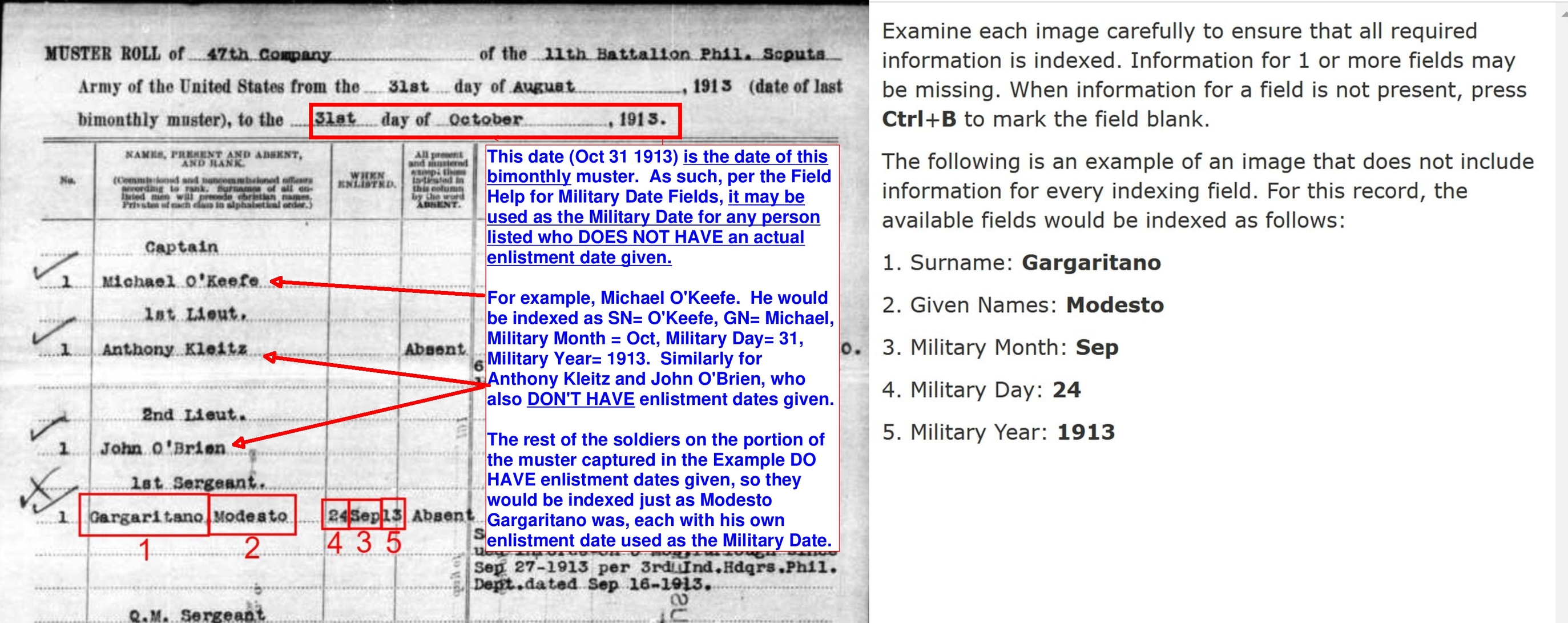COMMENTS on:United States—Enlisted and Officer Muster Rolls and Rosters, 1916–1939 [Part L]

I intend these comments for Indexers new to the Muster Rolls and Rosters Project. As with any project new to you - carefully read and understand all Instructions and Field Helps.
In the last Part (K) of the Muster Rolls and Rosters project, I complained/ claimed that Indexing Example #2 was incorrect in taking the first date given on a bi-monthly muster as the date of that muster. Well, they've removed that Example. But none of the four indexing examples shows how to deal with a bi-monthly muster date, nor any situation that uses the Muster Roll or Roster date as the Military Date for a solder whose enlistment date was absent. Every Indexing Example has an enlistment date available to use as the Military Date.
So we have this Field Help instruction: "The date at the top of a roster or roll may be used for all entries as the military date if the entries don't contain their own individual enlistment dates." And no example to illustrate how to deal with it.
I am still concerned about the proper indexing of the date of bimonthly rolls. Plus, I have reviewed several batches indexed with blank Military Dates when enlistment dates or roll or roster dates were available. Others indexed the muster roll or roster date as the Military Date with enlistment dates available. So, I have chosen Indexing Example #3 to illustrate how properly to extract the date of a bi-monthly muster and index the case where a soldier doesn't have an enlistment date given.
Below is a further-annotated rendition of the upper portion of the Indexing Example #3:
Best Answer
-
Fortunately we are indexing not researching these confusing dates. The researcher can look at the dates and make their own decisions. At the very worst the dates will narrow the timeline for that researcher. An interesting conversation!
1
Answers
-
This looks like a good guideline.
0 -
Thank you, thank you!!! I hope the new indexers will see this and take note.
0 -
You’re welcome.
0 -
Thanks for the extra help.
0 -
Thanks for clarifying that.
0 -
Thanks, John, for the clarification. I had 2 different Muster Rolls today that had enlistment dates for each soldier but the indexer on one of them had a common date that he/she must have pulled out of the air because I never did find it. It was only about 30 entries so I redid it. The other one was no useable info with 50+ entries. I sent it back for reindexing. I hope everyone reads your coments.
0 -
You’re welcome, Dave.
That Indexer probably found that date on a prior (reference) image. But even if it is the correct muster roll or monthly or vi-monthly roster date, as you know, it should only be used for soldiers who don’t have actual enlistment dates given. Read on for more details on determining the date of a roll or roster.
Often the batch image in this Project is a continuation page of a roll or roster that began on a prior image. If you’re lucky, the first page is within reference images -1 through -5. Use the 4th (last) vertical icon to show or hide the reference images Typically the Muster Roll or Roster date (and so the date of your image too) is at the top of that first page.
The Field Help (FH) for Military Year - purple question mark that appears when you click in a field - tells us that we may look back to determine the Military Year. There is no such language in the FH for Military Month or Military Day. But we’ve been told by those in charge that we may use all three date components if we can find them on a prior image.
Note: Sometimes for a very large roll or roster you may need to go forward to the +1 through +5 reference images to find a military date you can use. It might be where the adjutant signs off on the document, often at the bottom, and could be a day or two after the end of the prior month. And sometimes you never find the beginning nor end of a huge roll or roster within your batch and reference images and a date you can use.
0 -
I just saw this post and have a question. In your "further annotated rendition of the upper portion of the Indexing Example #3" I noticed that you put a red box around "31st day of October, 1913" as the date of this bimonthly muster which you indicate would be used by some of the soldiers listed on this page who don't have their enlistment date given. In the past, I have called the Indexing help line in Salt Lake City (1-866-406-1830) to ask various questions and have asked more than once concerning the Bimonthly muster date as to which date to use, the earlier one or the later one? I have been told the earlier one is the one to use. So which is correct? Who has the last word? Also, If there is an reenlistment date, that can be used, right? Sorry to be such a pain, but I want to do this as correctly as possible. Thank you for your help. I appreciate it.
0 -
Yes, a re-enlistment date is an enlistment date (date of a second or later enlistment), so it has priority over any other military date (except its own earlier predecessor) according to the priority list in the Military Date field help.
Regarding the bimonthly muster/roster - the folks in Salt Lake City (not I) have the final say on the projects, in consultation with the Project Managers. Nonetheless, the correct date of a bimonthly muster/roster is the second date. Look at the following typical bimonthly muster/roster header to justify my claim. I suppose FS can make an exception and say to use the first date as the military date. If so, I would like to know why they singled out bimonthly rosters/musters for that odd treatment.
The first date of the above two dates is identified, in parentheses, as the date of the LAST bimonthly muster (not the date this one). Likewise, the next bimonthly roster would be the 31-Oct-1913 to 31-Dec-1013 (using the same convention as is used here), and on it, that 31-Oct--1913 date will be identified as the "date of last bimonthly muster" - namely this one.
So, the musters themselves tell us that date of a bimonthly muster/roster is the second date. And it makes sense - these two-month musters contain a list of soldiers who were in the unit during the two-month period ending on that second date. Any exceptions - people who joined or left during the two months - are noted within.
1 -
Another way to look at this is:
The date of a Monthly roll or roster is the last day of that monthly period - the date of the last day of the monthly period - not the first day. For example October 31, 1913 for an October 1913 monthly roll or roster.
Likewise, the date of a bimonthly muster roll or roster is the last day of that two-month period - not the first day. For or example October31, 1913 in the case of our bimonthly muster for the two-month period ending on October 31, 1913.
Each of these is an accounting taken at the end of a one or two month time period - the date of reckoning. The date of the respective document.
2 -
All of what you have said makes sense. Thank you for your clarification and time in explaining it all. I think the reason why it seemed like FS in SLC singled out bimonthly rosters/musters was because I asked specifically about those. When I was reviewing those, I would get a batch that was done one way (using the earlier date) and then another batch that was done using the later date. It is good to get an explanation like you have given, that helps me understand. Thank you again.
0 -
You're very welcome, @jonemari .
0

